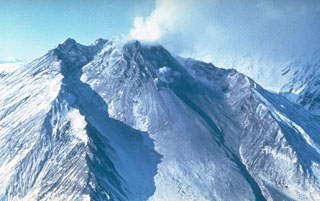Report on Bezymianny (Russia) — 21 December-27 December 2016
Smithsonian Institution / US Geological Survey
Weekly Volcanic Activity Report, 21 December-27 December 2016
Managing Editor: Sally Sennert.
Please cite this report as:
Global Volcanism Program, 2016. Report on Bezymianny (Russia) (Sennert, S, ed.). Weekly Volcanic Activity Report, 21 December-27 December 2016. Smithsonian Institution and US Geological Survey.
Bezymianny
Russia
55.972°N, 160.595°E; summit elev. 2882 m
All times are local (unless otherwise noted)
KVERT reported strong gas-and-steam emissions at Bezymianny during 16-23 December; a gas-and-steam plume drifted about 60 km SW on 18 December. A daily thermal anomaly was detected over the volcano. The Aviation Color Code remained at Orange.
Geological Summary. The modern Bezymianny, much smaller than its massive neighbors Kamen and Kliuchevskoi on the Kamchatka Peninsula, was formed about 4,700 years ago over a late-Pleistocene lava-dome complex and an edifice built about 11,000-7,000 years ago. Three periods of intensified activity have occurred during the past 3,000 years. The latest period, which was preceded by a 1,000-year quiescence, began with the dramatic 1955-56 eruption. This eruption, similar to that of St. Helens in 1980, produced a large open crater that was formed by collapse of the summit and an associated lateral blast. Subsequent episodic but ongoing lava-dome growth, accompanied by intermittent explosive activity and pyroclastic flows, has largely filled the 1956 crater.

